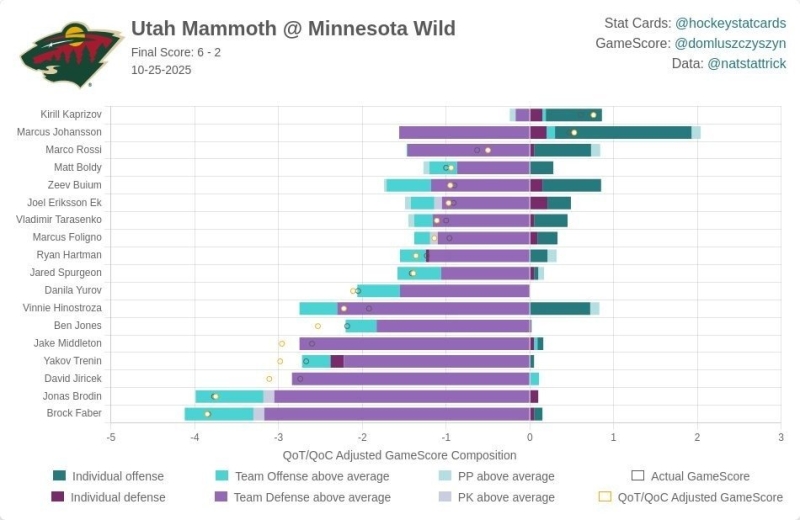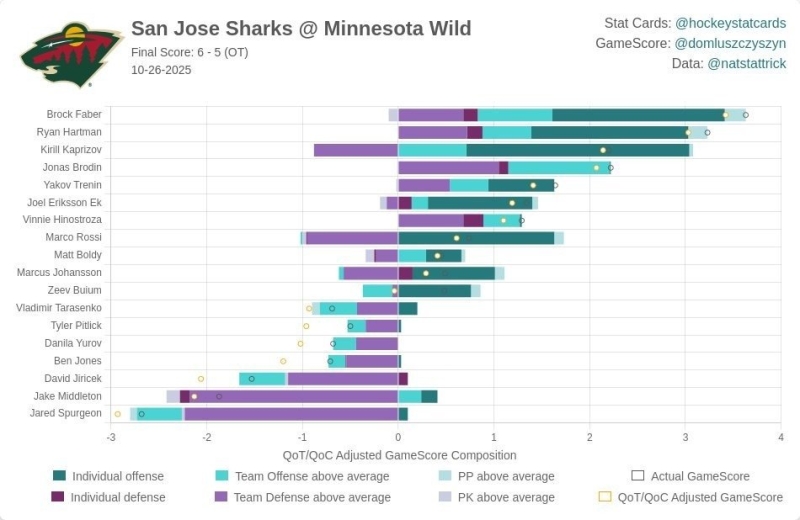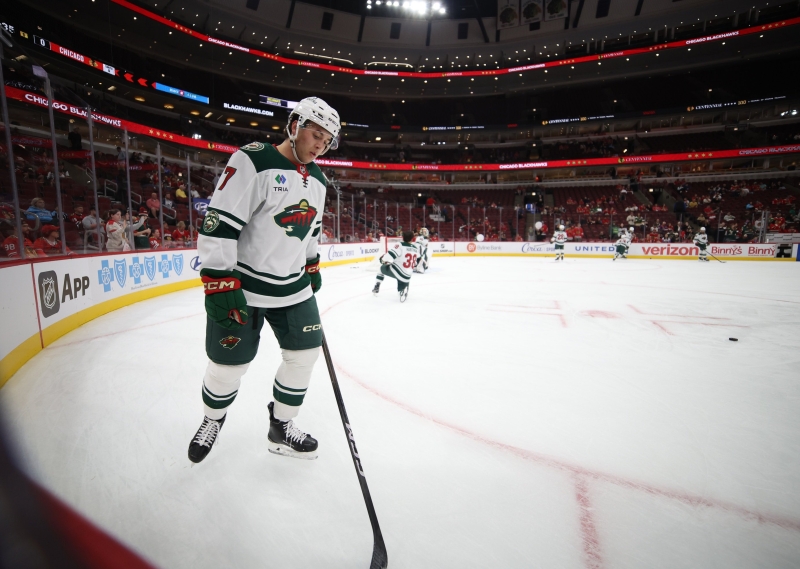The Minnesota Wild were undoubtedly hoping for a better start to the season than their 3-5-2 record. While the campaign is still early, 10 games are enough to gather some data on how a team is playing. Little has gone right in Minnesota, but it’s easy to pick out a few areas where the team has struggled.
One of the team’s most notable deficiencies has been the play of anchor defender Brock Faber. The Wild signed Faber long-term last year to be a steadying force on the blue line. He may not score the most points, but the team counts on him to play the most and hardest minutes. So far this year, he hasn’t lived up to his standard.
Brock Faber’s early-season struggles are a bit irregular for the player, which is particularly concerning. He’s gone through tough stretches in his career, but up to this point, they’ve been easy to explain.
In Faber’s rookie season, he had an excellent first half of the campaign before dealing with rib injuries that derailed his late-season play. Faber got off to a great start again last season, but it seemed that the longer the season went on, the more difficulty he had upholding such a strenuous workload.
Faber is still playing a lot of minutes, but less than he has in years past. He’s averaging 23:05 of time on ice this season compared to 25:03 for his career. He shouldn’t be experiencing fatigue this early in the season. As far as we know, Faber isn’t dealing with any significant injuries. So what gives? Are Faber’s early-season issues just working out some kinks? Or is there a genuine reason for concern about the Wild’s franchise defender?
Let’s start with where Faber is having issues. His offensive production has been his most glaring weakness. While Faber is supposed to be a lockdown defender, he has also contributed offensively in the past.
In the first nine games of the 2025-26 season, Faber had no points, and his expected goals for/60 is the lowest of his career at 2.51. For comparison, last year the Wild produced an expected 2.89 goals/60 with him on the ice, up from 3.07 in his rookie year. Faber’s possession numbers are also down, with a career low 45.09% Corsi-For rating.
Faber’s defensive metrics aren’t much better. He’s setting career marks in expected goals against/60 with 3.59 and high danger chances created against/60 with 14.03.

(Source: Naturalstattrick.com)
Stats tell part of the story, but they’re just a representation of results. The more vital piece of the puzzle is figuring out what Faber is doing on the ice that is leading to those poor results.
The most obvious thing that has stood out about Faber’s play is that he’s performing like he’s frustrated. He’s second on the team among defenders in giveaways with 11. He’s holding onto the puck too long, trying to make plays, which is also leading him to absorb a lot of contact. His 6.98 hits taken/60 is the second-highest on the team among defenders.
For a pure encapsulation of everything that’s gone wrong this season for Faber, you don’t have to look any further than the Wild’s October 25 game against the Utah Mammoth.
Minnesota lost the contest 6-2, with Faber being on the ice for three of Utah’s goals. He played poorly defensively and had a bad giveaway that led directly to a Mammoth goal. Faber had a few shots on goal, but it wasn’t enough to make up for all the negatives on a night where he was arguably the Wild’s worst player.

(Source: HockeyStatCards)
It’s easy to see what’s gone wrong for Faber, but it’s much more critical that the Wild discover how to get him right. Fortunately for Minnesota, its young star is willing to take accountability and get back to basics.
Faber acknowledged he needed to be better after the Mammoth game.
“I mean, I’m better than this. I know I am,” Faber said. “I thought I had opportunities to play a solid game, and I just gotta kind of go back to Square 1. I gotta defend better. I gotta limit my turnovers, and I gotta let the game come to me.”
Faber’s comments are refreshing, and he’s always been willing to take accountability when things aren’t going well. The reflection set up an opportunity for a major bounce-back game against the San Jose Sharks the next night.
While the 23-year-old defender’s game is still a work in progress, he showed encouraging signs against San Jose. He played on the power play consistently for the first time this year, and it finally got his offensive production flowing.
Faber had three assists, two of which came on the power play. The most encouraging aspect of his passing was how quickly the puck was coming off his stick.
Ryan Hartman’s goal above is the product of a simple passing play with the extra man, but that’s precisely the kind of thing Faber needs to be doing to limit turnovers and, as he said, let the game come to him. Faber receives the puck and immediately distributes it to an open Kaprizov. It’s always wise to get Kaprizov the puck on the power play.
The improvements in Faber’s game weren’t just limited to his offensive game, either. He had his most substantial effort defensively in several nights. He made a highlight play on Macklin Celebrini at the end of the game to send the contest to overtime.
This version of Faber is the one the Wild need to win games. He’s a shutdown defender who can make some contributions on offense. When he isn’t playing well, Faber seems like he’s chasing the game. At his best, he lets the play flow through him.
Unfortunately, Faber had some bad luck in overtime and couldn’t corral his own rebound on a shot where he got a little too aggressive, allowing Celebrini to create a turnover and score on a breakaway. While losing a puck battle that leads to a highlight-reel game-ending play is easy to focus on, it’s more productive to recognize that Faber had a standout game.
In a complete turnaround from the disastrous game against the Mammoth, Faber was in the conversation for the Wild’s best player on Sunday night.

(Source: HockeyStatCards)
If the Minnesota Wild intend to reverse their early-season trajectory, they will require more nights like Faber’s performance against San Jose. His game still needs a bit more refinement, but the outing was a meaningful step toward restoring the standard he established in his first two NHL campaigns.
Faber may be young, but he is central to Minnesota’s success. He leads the team in ice time, carries the financial expectations of an $8.5 million cornerstone, and he’s clearly a leader. The Wild need him to find that level of his game consistently. A return to form from their franchise defender would go a long way in turning around the disappointing start to the Wild’s season.
